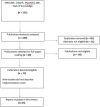Barriers to advance care planning at the end of life: an explanatory systematic review of implementation studies
- PMID: 25679395
- PMCID: PMC4334528
- DOI: 10.1371/journal.pone.0116629
Barriers to advance care planning at the end of life: an explanatory systematic review of implementation studies
Abstract
Context: Advance Care Plans (ACPs) enable patients to discuss and negotiate their preferences for the future including treatment options at the end of life. Their implementation poses significant challenges.
Objective: To investigate barriers and facilitators to the implementation of ACPs, focusing on their workability and integration in clinical practice.
Design: An explanatory systematic review of qualitative implementation studies.
Data sources: Empirical studies that reported interventions designed to support ACP in healthcare. Web of Knowledge, Ovid MEDLINE, CINAHL, PsycINFO, British Nursing Index and PubMed databases were searched.
Methods: Direct content analysis, using Normalization Process Theory, to identify and characterise relevant components of implementation processes.
Results: 13 papers identified from 166 abstracts were included in the review. Key factors facilitating implementation were: specially prepared staff utilizing a structured approach to interactions around ACPs. Barriers to implementation were competing demands of other work, the emotional and interactional nature of patient-professional interactions around ACPs, problems in sharing decisions and preferences within and between healthcare organizations.
Conclusions: This review demonstrates that doing more of the things that facilitate delivery of ACPs will not reduce the effects of those things that undermine them. Structured tools are only likely to be partially effective and the creation of a specialist cadre of ACP facilitators is unlikely to be a sustainable solution. The findings underscore both the challenge and need to find ways to routinely incorporate ACPs in clinical settings where multiple and competing demands impact on practice. Interventions most likely to meet with success are those that make elements of Advance Care Planning workable within complex and time pressured clinical workflows.
Conflict of interest statement
Figures
References
-
- National Confidential Enquiry into Patient Outcome and Death (2012) Time to interevene? Available: http://www.ncepod.org.uk/2012cap.htm accessed 2014 June 25.
-
- Department of Health (2008) End of Life Care Strategy: Promoting high quality care for adults at the end of their life. London: COI.
Publication types
MeSH terms
LinkOut - more resources
Full Text Sources
Other Literature Sources
Medical




